Many chessplayers become bogged down by the studying of openings. This is not the best way to improve ones chess game. It is far more important to understand ones strengths and weaknesses and how to eliminate ones shortcomings and develop ones strong points as a player and to fully understand your style of play and develop it accordingly. --paraphrased from "Training for the Tournament Player" by Dvoretsky and Yusopov.
Analyze your games and look for trends in your play. Do you lose material in the opening or early middle game? Then tactics is of utmost importance. Do you achieve good positions only to see them dwindle away, then position play with prophylaxis and suppressing counterplay needs attention. Do you reach endgames a pawn or two up and somehow still manage to lose? Then your endgame technique is seriously lacking.
On this page I show the results of my study on analyzing my own games. I especially concentrate on my weaknesses a chess player.
My preliminary evaluation of my "Chess Style"
Imaginative tactical player with solid mating pattern recognition. Needs space, and prefers development and the initiative to material considerations. Likes to control center.
Strengths and Weaknesses as of 11.22.02 (Nov 22 2002)
Strengths:
Weaknesses:
Not everyone has the same style of play. I like space and central control, development, open lines, and clear strategic planning. For example, I use to play the Gruenfeld Defense because it has a clear strategic plan of fighting against the enemy center, and also offers plenty of tactical opportunities. On the downside White can avoid it. I quit playing it after a couple of nasty losses where the white center just became too strong, not my cup of tea. This is one reason I have never really found a defense I like versus 1. d4.
I am trying not to focus on openings at this time, but they demonstrate some of my problems. I like space and tactical play so 1. e4 as white seems right. But defending against 1. d4 has always been a problem. I don’t defend pawn weaknesses well (and don’t like to) so openings like the Tarrasch with its isolated Queen pawn, or the Benoni with its backward pawn on d6 are out of the question (I got crushed playing the Modern Benoni once in just that manner). I don’t like cramped positions so the KID doesn’t seem right either, though I have won a few games with it (once black gets in f5 space it isn’t as big a problem). The QGD has space but often leads to the type of “quiet” positions I don’t enjoy playing and hence play rather poorly (yawn). And the Slav leads to sharp positions with way too much theory to learn. Perhaps some other openings are worth looking at like the Dutch, or the Budapest, which are not as heavily analyzed.
Looking at the list up top it seems my weaknesses outweigh my strengths as a chess player, but since I am not a master or even a rated expert (yet), that is to be expected. The goal is too improve my overall playing strength. The plan is to play to my strengths and to minimize my weaknesses.
The following position is from one of my most interesting games. I had the white pieces and the initiative throughout and actually threatened mate no less than 5 times though the game ended in a well-fought draw.
This is one of those times I let my imagination get away from me. I wanted to annihilate my opponent and played (diagram) 31. f5?! The point was to cut-off the black bishop from defending the g-line before playing Rg3+ which threatens mate with an attack. However it is a tactical error since 31. Rg3+! straightaway 31…Bg6 32. f5! wins a piece.
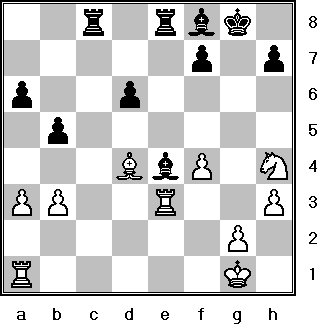
I retained an initiative however and had the interesting latent mate threat in the diagram below. I just played 37. Nf5! (heading to e7 when I threaten Rg8 mate) The knight is immune as 37…Bxf5?? Runs into the nice mate 38. Rg8+!, Rxg8 39. Rxe8#. The chance to play such tactics was way too tempting.
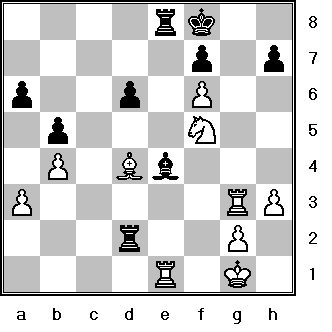
The following diagram shows one of my weaknesses. It is an opening from a Taimanov variation of the Sicilian after 1. e4, c5 2. Nf3, e6 3. d4 cxd4 4. Nxd4, Nc6 5. Nb5, d6 6. Bf4, e5 7. Be3, a6 8. N5c3, f5?! Blacks last was unsound. However I missed my chance to refute it with 9. Nd5! Busting black at once. If now 9…Nf6 then 10. Bb6!, Qd7 11. Nc7+ wins the rook on a8 and 9…Rb8 10. Bb6, Qh4 11. Nc7+, Ke7 12. Nc3 with a powerful initiative. I missed it, it never even occurred to me, simply because it would have been the 5th time this piece moved in the first 9 moves! It seems to violate opening principles, but yet it was correct. Instead I played 9. exf5? and eventually lost. I learned here that rules are sometimes made to be broken.
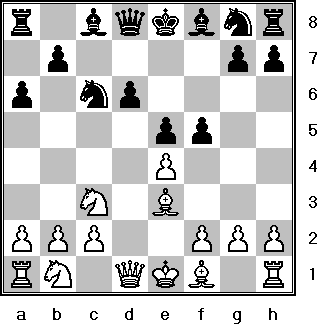
Here is an example of a type of position I don’t really like. It seems quiet but it really isn’t, I allowed black the bishop pair on an open board versus 2 knights and I lost. (See below)
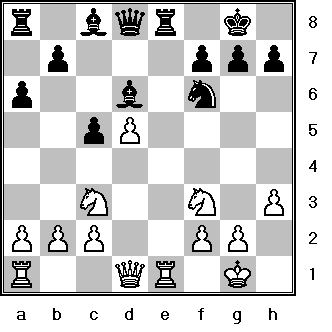
Black played 13…Rxe1+ 14. Qxe1, Bf5 and now I played 15. Qd1 to protect c2 and reinforce d5 and play continued 15…b5 16. Bg5, h6 16. Bxf6, Qxf6 17. a3, Re8 and black with his bishop pair and superior activity eventually won. I would have been better off playing 15. Qe2 intending Ne5 keeping my bishop on board.
The next example is from a training game. I am a piece ahead but totally on the defensive. I felt I "should" win this game because my opponent made an unsound sacrifice of a piece in the opening. However he definitely has a strong initiative. In the current position:
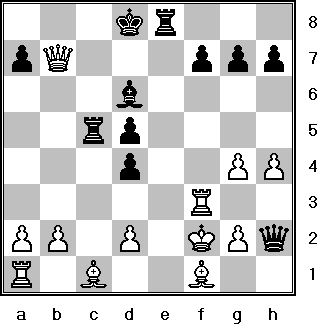
I probably should have took a draw here by repetition with 20. Rh3, Qf4+ 21. Rf3, Qh2 etc. Or better than what I actually played was 20. Qxf7!? But again believing I “should” win I played 20. Qa7+?! As Fischer once said, “Patzer sees check, Patzer gives check.” Black played 20…Bb8. and I continued 21. Rh3, Qf4+ 22. Kg1, Re1 23. Rf3, Qd6 and I’m tied up in knots and black soon won. Positions like this one, where I don’t have initiative, where I’m on the defensive I play particularly poorly and make bad judgements.
Ok Ok, you want to see a game where I get crushed. Here is a good one. I make a dumb tactical error and then only make things worse and get hammered into oblivion. (See Below)
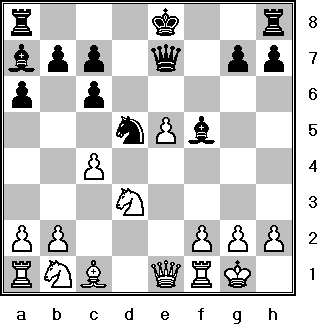
In the current position (above) I saw that 15. cxd5, Bxd3 and my rook is trapped, but after what I actually played I failed to see he could do the same thing. Oblivious I played 15. Nf4?? wanting to trade off the centralized knight and bring my bishop to f4 to reinforce my advanced central e-pawn, but I completely overlooked the end of the exchange. Play continued 15...Nxf4! 16. Bxf4, Bd3. Doh! Total chess blindness. (I should have played 15. Qe2 when I'm fine.) But it gets worse! To see the rest of the slaughter click HERE. This is a good example of me collapsing after a bad idea. Overlooking a shot and then defending terribly. Also if I had the black pieces I would never have missed that simple tactic as the aggressor. (Note this was in 1999. I have gotten much stronger since then.)
Lastly here is a position from one of my Gruenfeld losses. I played the opening correctly and got some counterplay in the middlegame. But even in this ending white has a strong center and soon won.

White has played 28. Rf2 and I responded 28...Rab8?! (diagram above) and after 29. d6! I eventually lost. Perhaps better was 28...Rxf2 29. Kxf2, Rd8 but after 29. e5+ white is still winning.
Well there we have a pretty fair analyses of my style, strengths and weaknesses as a chess player as of 2002.